How to Get Rid of Squash Bugs Before They Ruin Your Harvest
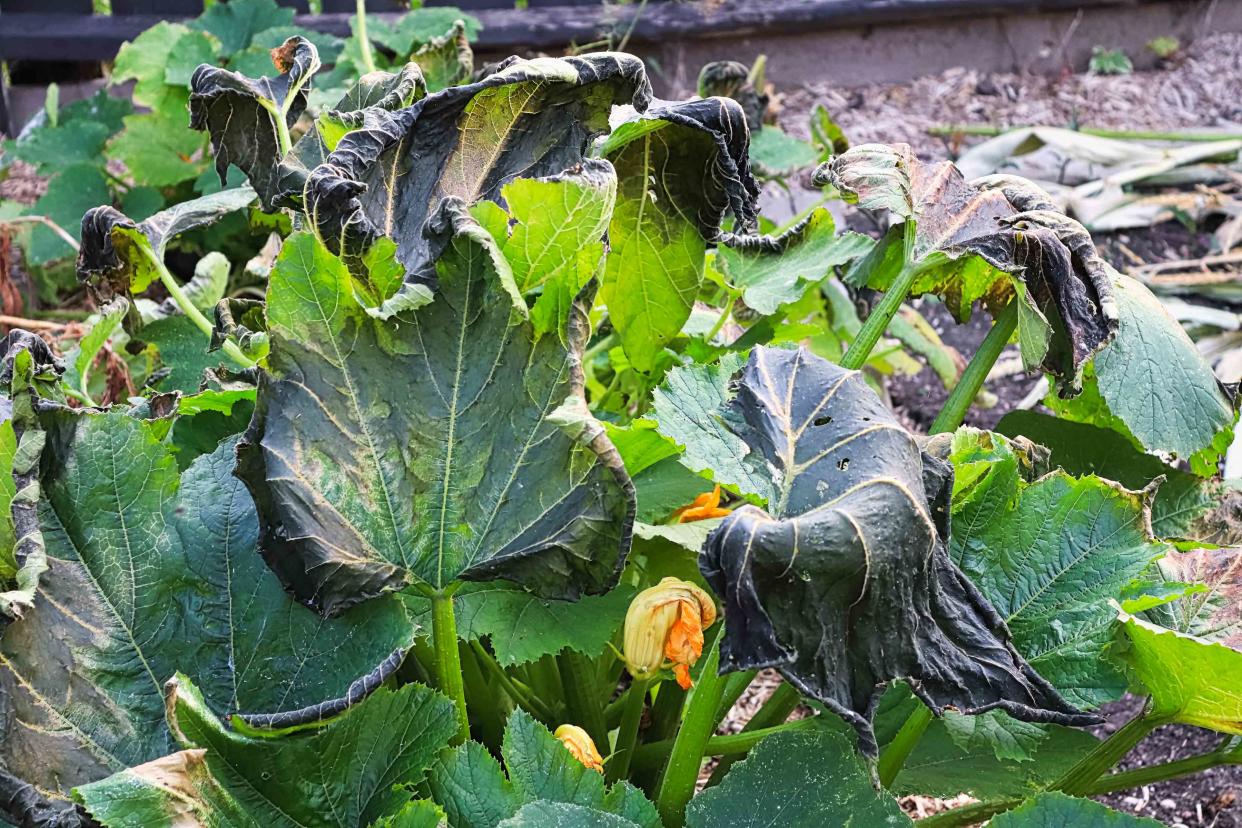
Akchamczuk / Getty Images
If you’ve noticed brown or gray insects with large, flat bodies scrambling over your precious zucchini, pumpkins, or squash, you may be dealing with a squash bug problem.
These pests feed on most Cucurbit plants, including melons, squash, and pumpkins. Signs of them include discolored leaves, stunted plants, and scarred fruit in their wake.
Squash bugs can be difficult to eradicate, so prevention is usually the best option. However, with consistency and the right tools, you can get rid of squash bugs using all organic pest control techniques.
Whether you have a squash bug infestation or you simply want to prevent these troublesome pests, this guide will teach you how to naturally pest-proof your vegetables and keep squash bugs away for good.
What Do Squash Bugs Look Like?
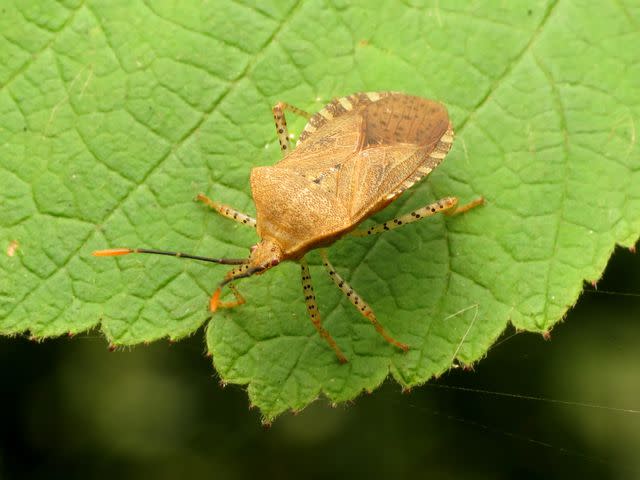
Katja Schulz / Flickr / CC BY 2.0
Squash bugs are often confused with assassin bugs, squash vine borers, and stink bugs, but these insects are different.
Squash bugs: These typically measure about ½ inch long and have flat, brown to gray bodies. Although these insects can fly, they typically walk and spend their time congregating on plant stems, leaves, fruit, and around plant crowns. Young squash bugs, also known as nymphs, look like miniature adults and they’re usually found in groups on the underside of plant leaves along with clusters of reddish-brown, oval-shaped squash bug eggs.
Stink bugs: Compared to stink bugs, squash bugs are a bit smaller and their bodies are relatively curvy, while stink bugs are more shield-shaped in form.
Squash vine borers: These are actually moths with orange and black bodies and wings.
Assassin bugs: These are the most like squash bugs, but assassin bugs are beneficial insects that feed on garden pests. The easiest way to differentiate is by their behavior—squash bugs are usually found in groups, while assassin bugs are solitary predators.
3 Ways to Identify Squash Bug Damage
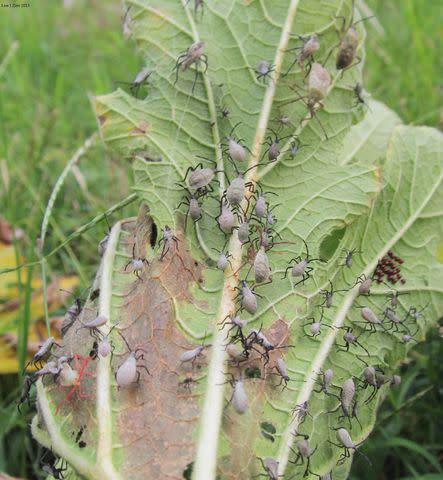
Lisa Zins / Flickr / CC BY 2.0
The easiest way to identify a squash bug infestation is to search for squash bugs and their eggs on the undersides of plant leaves. However, if you don’t see the squash bugs themselves, you may notice these signs of squash bug damage:
Discolored leaves. Squash bug saliva is toxic to plants and causes leaves to change colors. At first, you may notice yellow stippling on the leaves where squash bugs have been feeding, and as infestations progress, damaged leaves will wilt, brown, and become brittle.
Damaged fruit. Although squash bugs mostly target plant leaves, they’ll feed on fruit, like zucchini and melons. This causes scarring on the fruit skins.
Wilted, stunted, or dead plants. Intensive feeding can weaken plants and cause stunted growth and wilting. Established plants may be able to withstand a squash bug invasion, but large populations of squash bugs will often kill young plants.
Why You Should Get Rid of Squash Bugs
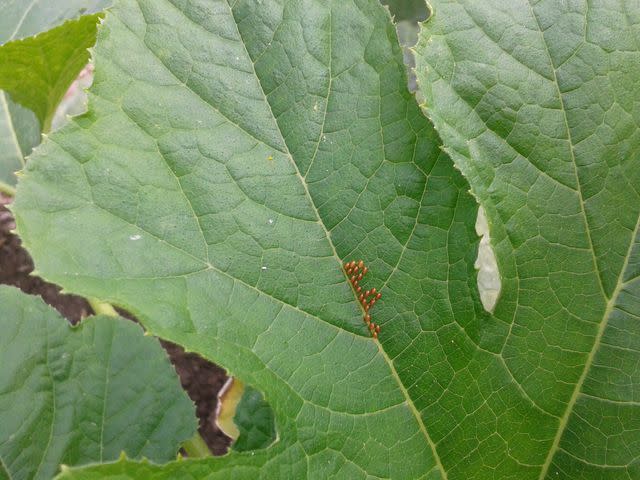
Raleigh City Farm / Flickr / CC BY 2.0
Squash bugs don’t spread as many plant diseases as cucumber beetles do, but they can still transmit Cucurbit Yellow Vine Disease (CYVD), which causes yellowing. Aside from this, heavy squash bug infestations weaken plants and reduce harvest yields.
Acting quickly at the first signs of squash bug problems is important as these pests can spread rapidly. Squash bugs also overwinter in old plant debris, so if you had a problem with squash bugs in the past, they may come back.
The Best Tips to Get Rid of Squash Bugs
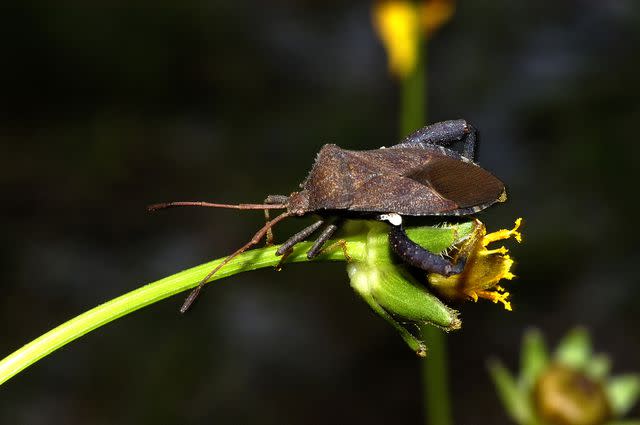
Squash bugs can be difficult to eradicate, but it is doable. For best results, combine several of the treatment methods below and be consistent with your pest control strategy.
Pest Control Tip
Repeating treatments several times will ensure you remove adult squash bugs, nymphs, and eggs too.
Start Early
Adult squash bugs overwinter in old leaf litter and reemerge in spring to early summer to lay eggs. Tackling squash bugs as soon as you see them keeps these pests from spreading and producing another generation of squash bugs.
If squash bugs do produce nymphs, act quickly, as nymphs are easier to treat with organic sprays than adults.
Look Under Leaves
One of the trickiest things about removing squash bugs is actually finding them. These pests are excellent hiders, but they can often be spotted lurking under plant leaves and around plant crowns. You may also find them hiding in the leaf litter surrounding infested plants.
Scrape Away Eggs
Squash bug eggs are typically laid in clusters on the underside of plant leaves. If you spot these reddish-brown, oval eggs, scrape them away with a butter knife or clip the entire leaf off and destroy it.
Avoid composting infested plant material, as squash bugs and other pests can often survive the composting process.
Try Handpicking
The fastest way to get rid of squash bugs and their nymphs is to handpick these pests into a bucket of soapy water. Place the bucket of water under the affected leaves and flick the squash bugs off the plant using your finger or a small stick.
Check plants every few days to ensure you catch new clusters of eggs before they hatch.
Encourage Natural Predators
Eggs and squash bug nymphs are particularly vulnerable to predatory insects, like parasitic wasps, ground beetles, assassin bugs, and ladybugs.
Invite these “good guy” insects into your garden by companion planting with flowering herbs, like parsley, dill, and cilantro. Keep gardens as organic as possible to give these beneficial bugs a safe place to do their work.
Make a Trap
Lay sheets of wet newspaper, large flat stones, or pieces of cardboard on the soil near infested plants in the evening, check the “traps” early the next morning, and destroy any squash bugs you find.
Apply Organic Sprays
Insecticides aren’t that effective against adult squash bugs, but organic soap sprays can be used to tackle nymphs.
After handpicking as many squash bugs as you can, apply soap sprays to the tops and undersides of infested leaves, and reapply the treatment every 3 to 5 days until the squash bugs are gone.
Tips for Spraying
Remember to avoid using sprays during the heat of the day, and don’t spray plant flowers—organic products can unintentionally harm pollinators, too.
Be Consistent
Squash bug eggs take about 10 days to hatch into nymphs, so it’s a good idea to check plants every few days to make sure new eggs aren’t being laid. Consistently hand-picking eggs and squash bugs is the best way to interrupt the squash bug life cycle and prevent new eggs from hatching.
5 Tips to Prevent Squash Bugs from Coming Back
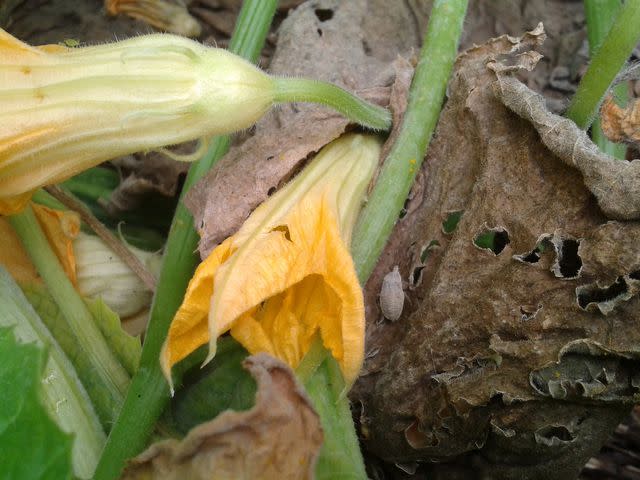
Raleigh City Farm / Flickr / CC BY 2.0
Eradicating squash bugs is step one. However, squash bugs are likely to return to gardens if you don’t take certain steps to protect your plants and prevent pest problems.
Try some of these prevention tips to keep your garden squash bug-free!
Choose resistant plants. Winter squash and pumpkins are especially vulnerable to squash bug attacks, but there are some Cucurbits that squash bugs just don’t like. If you’ve struggled with squash bugs in the past, consider growing resistant plant varieties, like butternut, ‘Sweet Cheese,’ and ‘Royal Acorn’ squash.
Install row covers. Installing row covers as soon as you move plants outside is an easy way to prevent pests. To ensure a good harvest of fruit, remove the row covers when your plants begin to flower or hand-pollinate the blossoms with an old makeup brush or Q-tip.
Rotate crops. Rotating crops on a 3 to 5-year cycle keeps squash bugs from overwintering in gardens and plaguing plants year after year. Combine crop rotation with row covers for even better results.
Use companion plants. Some plants naturally repel squash bugs, while others attract predatory insects that feed on squash bug eggs and nymphs. For natural squash bug control, try companion planting with plants in the carrot family, yarrow, borage, zinnias, sunflowers, chives, or nasturtiums.
Do a fall garden cleanup. Wait until spring to clean up garden beds, since pollinators overwinter in old leaf litter. However, because squash bugs can hide out in old plant debris, it’s wise to destroy any infested plant material in the fall to keep squash bugs from returning.
Frequently Asked Questions
Does dish soap kill squash bugs?
Yes. Dish soap kills squash bugs and dropping squash bugs into a bucket of soapy water is one of the best ways to keep these pests in line. However, organic insecticidal soap sprays are gentler on plant leaves and they are a better option if you intend to apply sprays directly to plants.
What can I use to kill squash bugs instantly?
To kill squash bugs almost instantly, drop them into a bucket of soapy water or crush them underfoot.
Read the original article on The Spruce.

